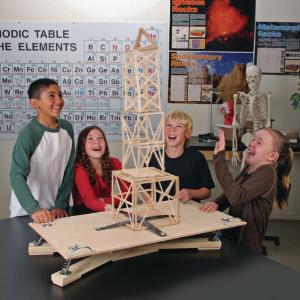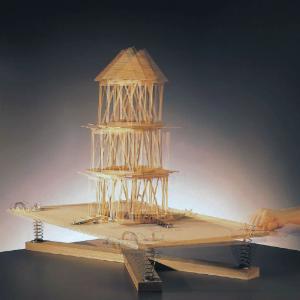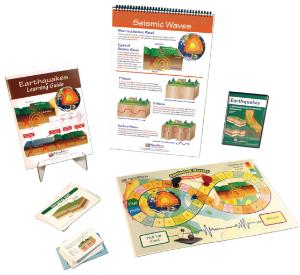Earthquake Facts to Shake Things Up; Plus a Free Student Handout from AccessScience
Help students separate fact from friction when it comes to the motion of the Earth’s crust and the movement of its tectonic plates.
Access to this content is available to Ward's World readers for free from McGraw Hill's AccessScience, an award-winning, digital STEM resource containing exclusive articles written by expert scientists and engineers; biographies of well-known scientific figures; science news, videos, and animations; and much, much more.
Instructors can use AccessScience to guide students on their research project journeys, to help students understand scientific concepts, to support distance learning efforts, in flipped classroom approaches, and in countless other ways.
Ward’s World and AccessScience have partnered to offer educators a no-obligation, free trial subscription to AccessScience. Request your free trial today to discover how valuable AccessScience can be for you and your students! Get your free trial now.
Middle School/High School
You can’t blame students for being excited about the science of earthquakes; it’s not their fault.
The Earth science lovers in your class will enjoy discovering the facts about the motion of the Earth’s crust and the movement of its tectonic plates. And unlike the rest of us these days, tectonic plates are still greeting each other by “shaking lands,” ba-dum-TSH.
Earthquakes are among nature’s most destructive events. They’ve inspired a lot of MEGA disaster films from Hollywood over the years. Despite the fantasy disasters dreamed up by screenwriters and special effects geniuses, the students in your class can use your lessons to help them separate science facts from science fiction. Here are some common fact vs. fiction notions about earthquakes as reported by the United States Geological Survey agency:
FACT: Earthquakes are sudden rolling or shaking events caused by movement under the Earth’s surface.
An earthquake is the ground shaking caused by a sudden slip on a fault. Faults are caused by the tectonic plates grinding and scraping against each other as they continuously and slowly move.
FICTION: “Mega Quakes” can really happen.
Megathrust earthquakes (mega quakes) occur at subduction zones at destructive convergent plate boundaries. One tectonic plate is forced underneath another, caused by slip along the thrust fault that forms the contact between them. These interplate earthquakes are the planet's most powerful, with moment magnitudes (Mw) that can exceed 9.0.1 The magnitude of an earthquake is related to the area of the fault on which it occurs - the larger the fault area, the larger the earthquake. The largest earthquake ever recorded by seismic instruments anywhere on the Earth was a magnitude 9.5 earthquake in Chile on May 22, 1960. A magnitude 12 earthquake would require a fault larger than the Earth itself; what a shocker!
FICTION: Earthquakes only occur on the West Coast in the United States.
Earthquakes can strike any location at any time. But history shows they occur in the same general patterns over time, mostly in three large zones of the Earth, i.e., the circum-Pacific seismic belt (The Ring of Fire), the Alpide belt, and the mid-Atlantic ridge (MAR).
FICTION: The 1906 San Francisco earthquake was the deadliest ever.
At magnitude 7.8, the San Francisco earthquake was undoubtedly massive and was the most deadly in U.S. history, causing fires that killed 3,000 people. But the deadliest earthquake in recorded history struck Shensi province in China in 1556, killing about 830,000 people. And, of course, the magnitude 9.5 earthquake in Chile as mentioned above.
PARTIALLY FACT: California has the most earthquakes in the United States.
Alaska registers the most earthquakes in a given year, with Oklahoma placing second as the most active in magnitude 3.0 and greater earthquakes. California, however, has the most damaging earthquakes because they occur in areas with a high population and extensive infrastructure.
FACT: Earthquakes can occur near the surface or deep below the surface.
Earthquakes occur in the crust or upper mantle, from the Earth’s surface to about 400 miles below the surface. But the deepest earthquakes only occur at subduction zones where cold crustal rock is being pushed deep into the Earth.
FICTION: The ground can open up during an earthquake.
What would a blockbuster earthquake movie be without a fault that opens to swallow up a few move extras? Luckily, that only happens in the movies! The ground on the two sides of the fault slides past each other; they don’t pull apart. If the fault could open, there would be no friction. Without friction, there would be no earthquake; that’s just science friction.
FICTION: California will eventually fall into the ocean.
The Pacific Ocean isn’t a big hole into which California can fall. The ocean is also just land at a lower elevation with water above it. The idea that California will be swept out to sea is absolutely impossible. Instead, southwestern California is moving horizontally northward towards Alaska as it slides past central and eastern California.
Fun Fact:
Los Angeles and San Francisco will one day (about 15 million years from now) be next-door neighbors, and in an additional 70 million years, Los Angeles residents will have to get used to an Alaska zip code!
FICTION: An earthquake on the San Andreas fault can cause a large tsunami.
The San Andreas fault can’t create a big tsunami like the ones that happened in Sumatra in 2004 or Japan in 2011. Those earthquakes happened on subduction zone faults, on which fault slip caused vertical uplift of the seafloor. The San Andreas fault is offshore, the motion is mostly horizontal, so it won’t cause large vertical motions of the ocean floor that would generate a tsunami. Phew!
With your Earth science lesson plans, students can learn what really happens when the Earth moves so they can separate earthquake facts from fiction at the movie theatre and everywhere else.
Scroll to the top of this page to download McGraw Hill’s AccessScience article, Earthquake; it has comprehensive facts on causes, classifications, sequences, prediction, and more to add to your lesson plans. The free download also includes assessment questions and answers you can use to test student understanding. It’s a valuable resource covering a seismic topic.
Download McGraw Hill’s AccessScience Teacher Answer key for this article here.
Recommended products
[StartProductBlock]

Shake, Rattle & Roll Earthquake Board
This wave maker earthquake board and kit makes seismic waves in the classroom.
[EndProductBlock]
[StartProductBlock]

Towering Toothpick Disaster Lab Activity
Using basic building materials, students design and build a three-story, earthquake resistance structure.
[EndProductBlock]
[StartProductBlock]
Seismograph Model
Creates a visual representation of the shock waves generated by an earthquake.
[EndProductBlock]
[StartProductBlock]

Earthquakes Curriculum Learning Module
A complete set of visual, digital, and hands-on resources to provide students with the skills to master key concepts on Earthquakes.
[EndProductBlock]
